Documents: Go to download!
- Owner's manual - (English)
- FIRST THINGS FIRST
- YOUR ACER NOTEBOOK TOUR
- USING THE KEYBOARD
- USING THE PRECISION TOUCHPAD
- USING A BLUETOOTH CONNECTION
- CONNECTING TO THE INTERNET
- SECURING YOUR COMPUTER
- BIOS UTILITY
- POWER MANAGEMENT
- TRAVELING WITH YOUR COMPUTER
- UNIVERSAL SERIAL BUS (USB)
- USB TYPE-C PORT
- SD CARD READER
- VIDEO AND AUDIO CONNECTORS
- HDMI
- FREQUENTLY ASKED QUESTIONS
- Troubleshooting
Table of contents
USER’S MANUAL Computing
FIRST THINGS FIRST
We would like to thank you for making this Acer notebook your choice for meeting your mobile computing needs.
Your guides
To help you use your Acer notebook, we have designed a set of guides:
First off, the Setup Guide helps you get started with setting up your computer.
The Quick Guide introduces you to the basic features and functions of your new computer. For more on how your computer can help you to be more productive, please refer to the User’s Manual. This guide contains detailed information on such subjects as system utilities, data recovery, expansion options and troubleshooting.
Once you have connected to the internet, you can download updates for your computer from: go.acer.com/?id=17883
- The link will open the Acer Service & Support webpage.
- Scroll down to Drivers and Manuals and search for your model by pasting in or manually entering the serial number, SNID, or product model.
- From this page you can also download and install the Acer identification utility that will automatically detect your computer’s serial number and SNID and allow you to copy it to the clipboard.
- Once you have found your product model, any updates, or documents will be listed.
Basic care and tips for using your computer
Turning your computer off
To turn the power off, do any of the following:
- Use the Windows shutdown command: Press the Windows key or select the Windows Start button, select Power > Shut down.
- Right-click the Windows Start button > Shut down or sign out > Shut down.
If you need to power down the computer for a short while, but don’t want to completely shut it down, you can put it to Sleep by doing any of the following:
- Press the power button.
- Press the sleep hotkey.
- Press the Windows key or select the Windows Start button, select Power > Sleep.
- Right-click the Windows Start button > Shut down or sign out > Sleep
Taking care of your computer
Your computer will serve you well if you take care of it.
- Only use the adapter provided with your device, or an Acerapproved adapter to power your device.
- Do not expose the computer to direct sunlight. Do not place it near sources of heat, such as a radiator.
- Do not expose the computer to temperatures below 0º C (32º F) or above 50º C (122º F).
- Do not subject the computer to magnetic fields.
- Do not expose the computer to rain or moisture.
- Do not spill water or any liquid on the computer.
- Do not subject the computer to heavy shock or vibration.
- Do not expose the computer to dust or dirt.
- Never place objects on top of the computer.
- Do not slam the computer display when you close it.
- Never place the computer on uneven surfaces.
Taking care of your AC adapter
Here are some ways to take care of your AC adapter:
- Do not connect the adapter to any other device.
- Do not step on the power cord or place heavy objects on top of it. Route the power cord and any cables away from where people walk.
- When unplugging the power cord, do not pull on the cord itself but pull on the plug.
- The total ampere ratings of the equipment plugged in should not exceed the ampere rating of the cord if you are using an extension cord. Also, the total current rating of all equipment plugged into a single wall outlet should not exceed the fuse rating.
Cleaning and servicing
When cleaning the computer, follow these steps:
- Turn off the computer.
- Disconnect the AC adapter.
- Use a soft, moist cloth. Do not use liquid or aerosol cleaners.
If your computer is dropped or visibly damaged, or does not work normally, please contact your nearest authorized Acer service center.
YOUR ACER NOTEBOOK TOUR
After setting up your computer as illustrated in the Setup Guide, let us show you around your new Acer computer.
Screen view

| # | Icon | Item | Description |
| 1 | Webcam |
Web camera for video communication. A light next to the webcam indicates that the webcam is active. | |
| 2 | Screen with lay-flat hinge | Displays computer output. | |
| 3 | Microphones | Internal stereo digital microphones for sound recording. |
Keyboard view
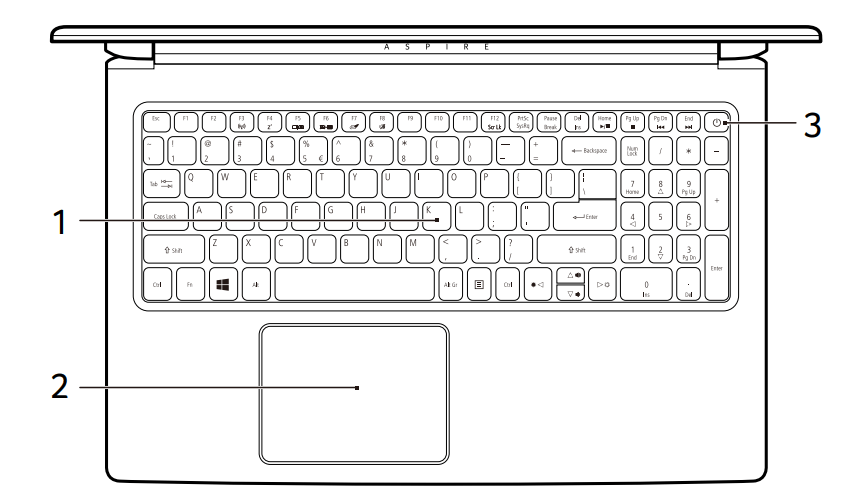
| # | Icon | Item | Description |
| 1 | Keyboard |
For entering data into your computer. See "Using the keyboard" on page 13. | |
| 2 | Touchpad | Touch-sensitive pointing device. The touchpad and selection buttons form a single surface. Press down firmly on the touchpad surface to perform a left click. Press down firmly on the lower right corner to perform a right click. | |
| 3 |  | Power button | Turns the computer on and off |
Left view

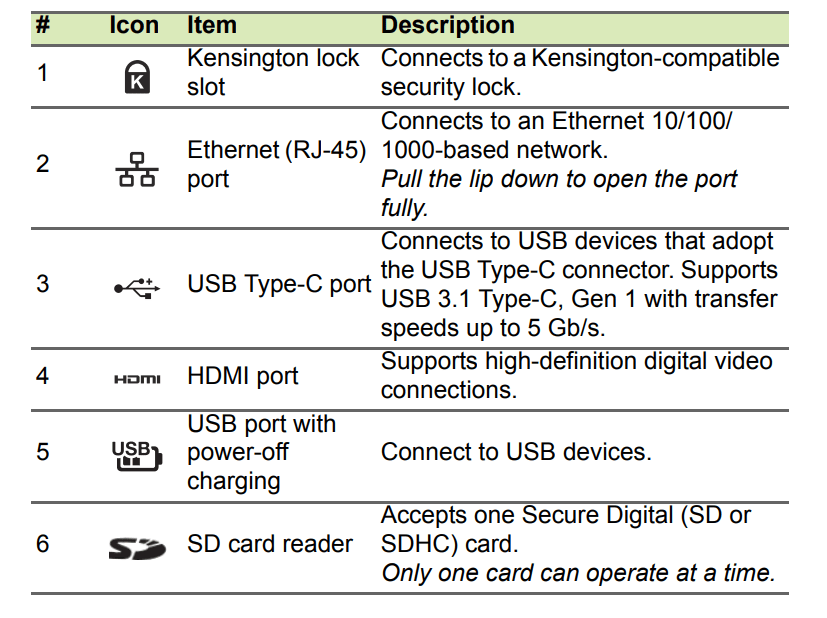
Right view

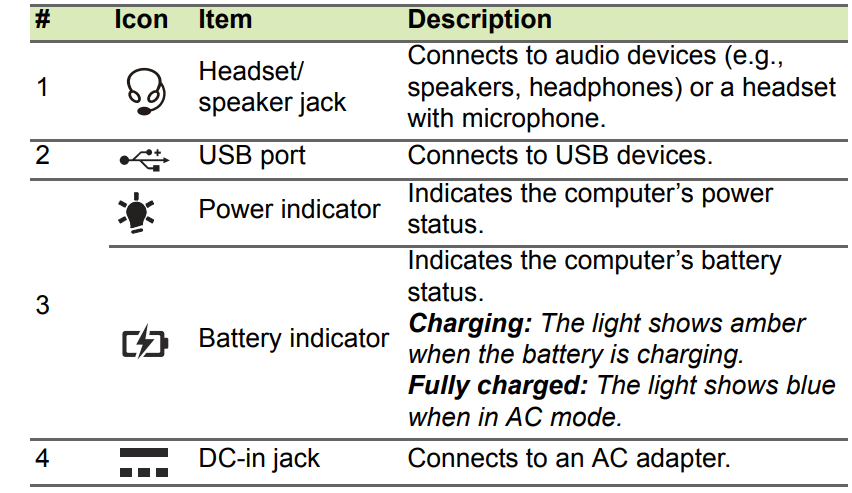
USB 3.0 information
- USB 3.0 compatible ports are blue.
- Compatible with USB 3.0 and earlier devices.
- For optimal performance, use USB 3.0-certified devices.
- Defined by the USB 3.0 specification (SuperSpeed USB)
Base view
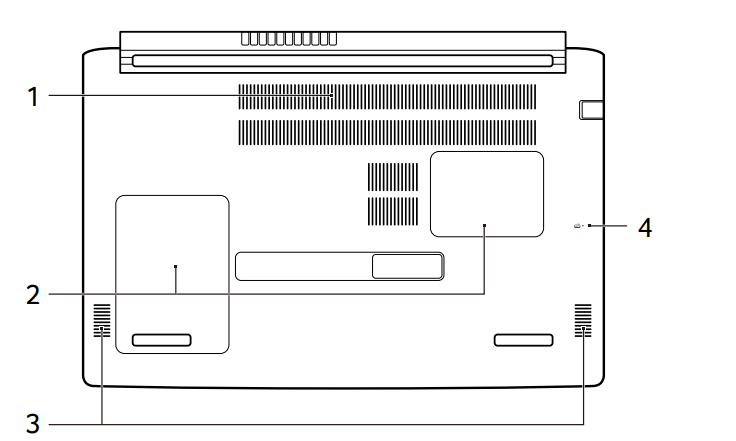
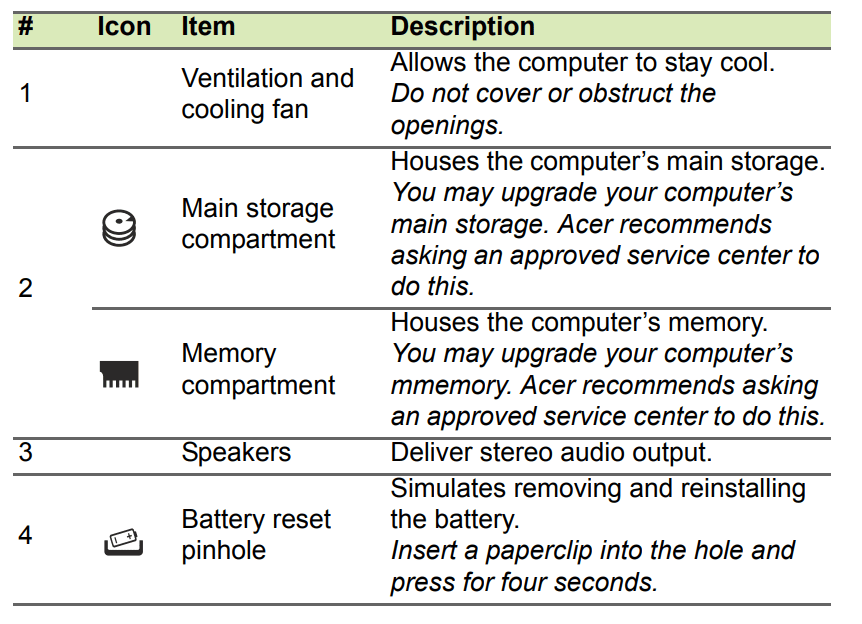
USING THE KEYBOARD
The keyboard has full-sized keys and a separate numeric keypad, separate cursor, lock, Windows, function and special keys.
Lock keys
The keyboard has lock keys which you can use to turn keyboard functions on and off
| Lock key | Description |
| Caps Lock | When Caps Lock is on, all alphabetic characters typed are in uppercase. |
| Num Lock | When Num Lock is on, the keypad is in numeric mode. The keys function as a calculator (complete with the arithmetic operators +, -, *, and /). Use this mode when you need to do a lot of numeric data entry. |
| Scroll Lock Fn + F12 | When Scroll Lock is on, the screen moves one line up or down when you press the up or down arrow keys respectively. Scroll Lock does not work with some applications |
Hotkeys
The computer employs hotkeys or key combinations to access most of the computer's controls like screen brightness and volume output.
To activate hotkeys, press and hold the Fn key before pressing the other key in the hotkey combination.

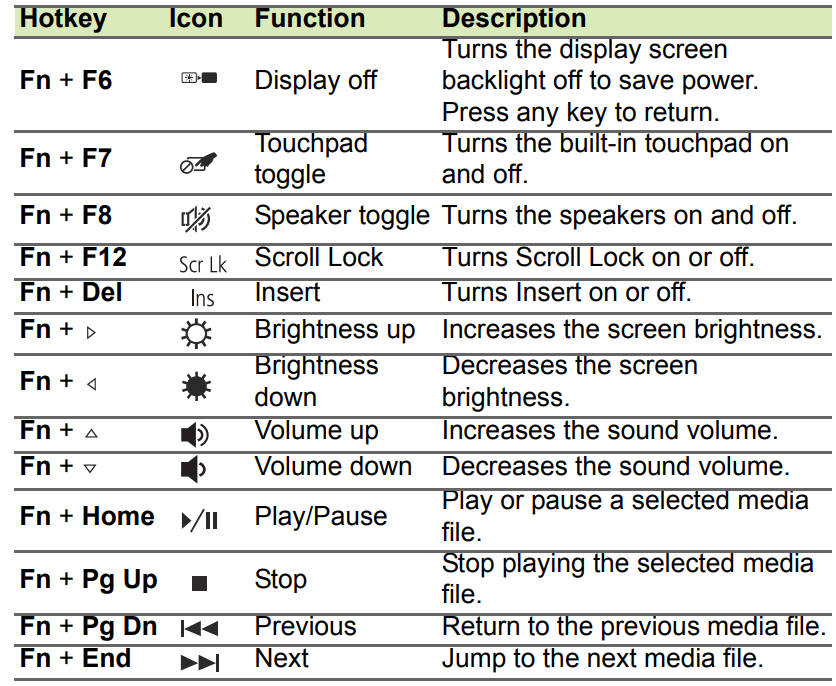
Windows keys
The keyboard has two keys that perform Windows-specific functions.

USING THE PRECISION TOUCHPAD
The touchpad controls the arrow  (or 'cursor') on the screen. As you slide your finger across the touchpad, the cursor will follow this movement. The Precision Touchpad (PTP) is designed to provide a more uniform, smooth, and accurate touchpad experience. Many applications support precision touchpad gestures that use one or more fingers, however, some gestures may not be supported by the specific application or program you are using.
(or 'cursor') on the screen. As you slide your finger across the touchpad, the cursor will follow this movement. The Precision Touchpad (PTP) is designed to provide a more uniform, smooth, and accurate touchpad experience. Many applications support precision touchpad gestures that use one or more fingers, however, some gestures may not be supported by the specific application or program you are using.
Touchpad gestures
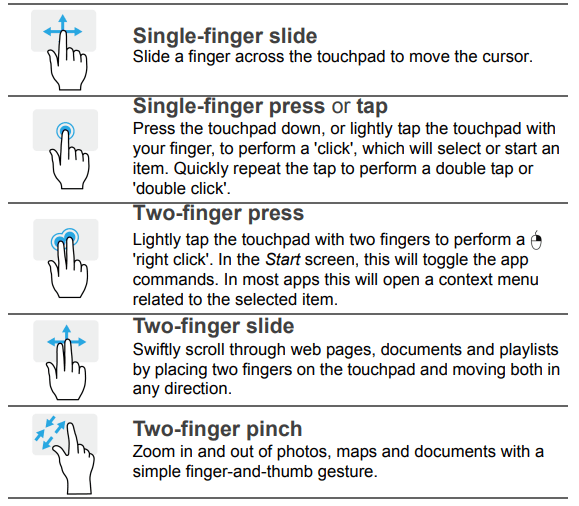

The precision touchpad includes added technology features that help recognize and prevent unintentional gestures such as accidental taps, gestures, and pointer movement.
Changing touchpad settings
To change the touchpad settings to suit your personal requirements, please do the following.
1.In the icon tray in the lower right-hand corner of the screen, select the Notifications icon to open the Notifications pane.

2.Select All settings.

3.Select Devices > Mouse & touchpad.
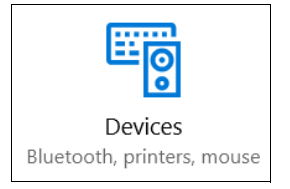
4.Now you can adjust the settings to suit your personal needs. You can change the primary button for left- or right-handed use, turn the touchpad off if you prefer to use a mouse, or set a delay to prevent the cursor from moving if you accidentally tap the touchpad with your palm while working. Scroll down to see more settings.
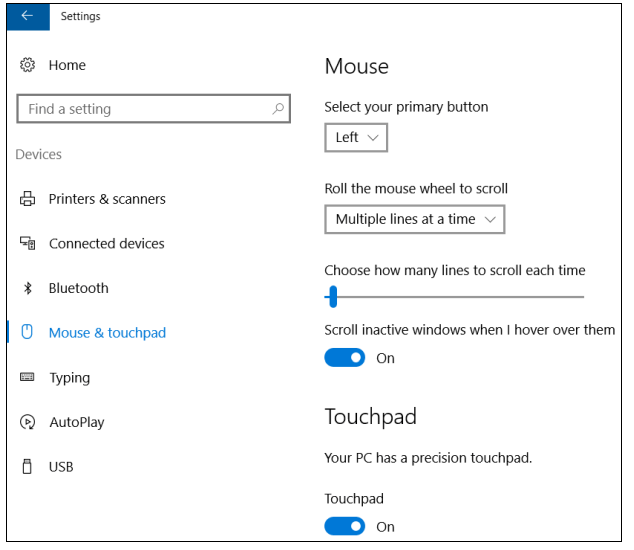
USING A BLUETOOTH CONNECTION
Bluetooth is a technology enabling you to transfer data wirelessly over short distances between many different types of devices. Bluetooth-enabled devices include computers, cell phones, tablets, wireless headsets, and keyboards.
To use Bluetooth, you must ensure the following:
- Bluetooth is enabled on both devices.
- Your devices are "paired" (or connected).
Enabling and disabling Bluetooth
The Bluetooth adapter must be enabled on both devices. For your computer, this may be an external switch, a software setting, or a separate Bluetooth dongle plugged into the computer’s USB port (if no internal Bluetooth adapter is available).
Enable Bluetooth and add a device
Every new device must first be "paired" with your computer’s Bluetooth adapter. This means it must first be authenticated for security purposes. You only need to pair once. After that, simply turning on the Bluetooth adapter of both devices will connect them. Bluetooth on your computer is disabled by default. To enable your computer’s Bluetooth adapter, do the following:
- Press the Windows key or select the Windows Start button > Settings > Devices > Bluetooth, and click the toggle under Bluetooth to enable/disable it.
- Your computer will automatically start searching for devices, as well as make itself visible to other devices.
- Select the device you wish to pair from the list of discovered devices, and select Pair.
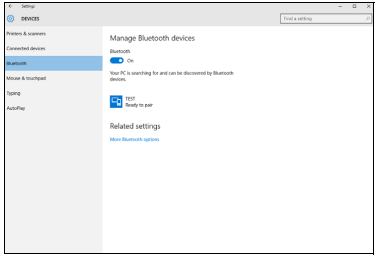
- A code displays on your computer, which should match the code displayed on your device. Select Yes. Then, accept the pairing from your device.
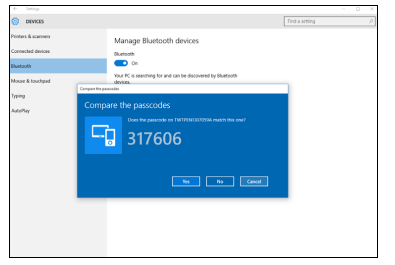
You can also enter the Bluetooth settings by selecting the Notifications icon in the lower right-hand corner of the screen to open the Notifications pane. From here, you can enable or disable Bluetooth or right-click on Bluetooth > Go to settings to enter the Bluetooth settings.
CONNECTING TO THE INTERNET
This chapter includes general information on types of connections, and getting connected to the internet. For detailed information, please refer to Network connections on page 66.
Your computer’s built-in network features make it easy for you to connect your computer to the internet.
First though, in order to connect to the internet from home, you’ll need to sign up for internet services from an ISP (Internet Service Provider) -- usually a phone or cable company -- that will have to go to your home or office to set up internet service. The ISP will install a small box, a router or modem, that will allow you to connect to the internet.
Connecting to a wireless network
Connecting to a wireless LAN
- A wireless LAN (or WLAN) is a wireless local area network, which can link two or more computers without using wires. Once connected to WLAN, you can access the internet. You can also share files, other devices, and even your internet connection itself.
- Your computer's wireless connection is turned on by default and Windows will detect and display a list of available networks during setup. Select your network and enter the password if required.
- Acer notebook computers feature an Airplane mode hotkey that turns the network connection on or off. You can use the network management options to turn your wireless network on/off or control what is shared over the network.
- To connect to a wireless network, please follow the steps below.
1.Ensure you have a wireless router/access point and current internet connection through the ISP of your choice. Make a note of the wireless network’s name and password (if necessary). If you are trying to connect to a public network (such as at a coffeeshop), make sure you have the wireless network’s name.
2.In the icon tray in the lower right-hand corner of the screen, select the Notifications icon to open the Notifications pane.

3.Select All settings.

4.Select Network & internet.

5.Make sure Wi-Fi is On and select Show available networks.
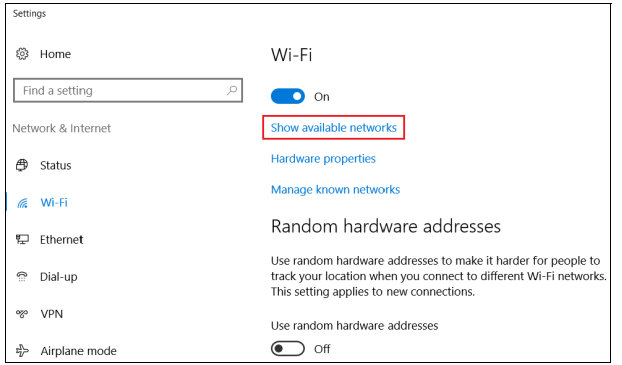
6.You will see a list of available wireless networks. Select the one you wish to use.
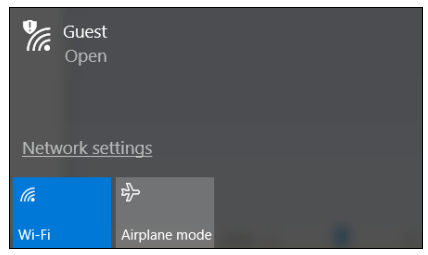
7.Once you select a wireless network, select Connect.
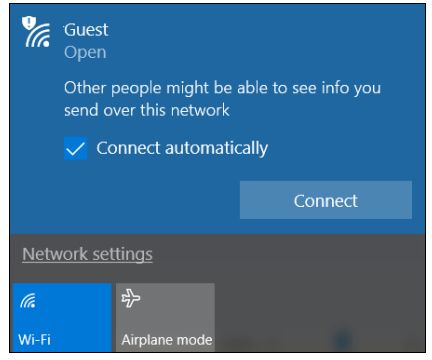
8.If required, enter the network’s password.

Connecting with a cable
Built-in network feature
- If your computer has a network port, plug one end of a network cable into the network port on your computer, and the other end into a port on your router (refer to the image below.) Then, you'll be ready to get online.

Connecting to a cellular network
- If your computer has a SIM slot, you can connect to the internet using a cellular phone network. To do this, you must have a compatible SIM card and a data contract with your cellular provider. Contact your cellular provider for more information on connecting to the internet using a cellular network.
SECURING YOUR COMPUTER
Your computer is a valuable investment that you need to take care of. Learn how to protect and take care of your computer.
Security features include hardware and software locks — a security notch and passwords.
Using a computer security lock
- The computer comes with a computer security slot for a security lock.
- Wrap a computer security lock cable around an immovable object such as a table or handle of a locked drawer. Insert the lock into the notch and turn the key to secure the lock. Some keyless models are also available.
Using passwords
Passwords protect your computer from unauthorized access. Setting these passwords creates several different levels of protection for your computer and data:
- Supervisor Password prevents unauthorized entry into the BIOS utility. Once set, you must enter this password to gain access to the BIOS utility. See Setting passwords on page 36.
- User Password secures your computer against unauthorized use. Combine the use of this password with password checkpoints on boot-up and resume from Hibernation (if available) for maximum security.
- Password on Boot secures your computer against unauthorized use. Combine the use of this password with password checkpoints on boot-up and resume from Hibernation (if available) for maximum security.
Entering passwords
When a password is set, a password prompt appears in the center of the display screen.
- When the Supervisor Password is set, a prompt appears when you enter the BIOS utility.
- Type the Supervisor Password and press Enter to access the BIOS utility. If you enter the password incorrectly, a warning message appears. Try again and press Enter.
- When the User Password is set and the password on boot parameter is enabled, a prompt appears at boot-up.
- Type the User Password and press Enter to use the computer. If you enter the password incorrectly, a warning message appears. Try again and press Enter.
BIOS UTILITY
The BIOS utility is a hardware configuration program built into your computer's BIOS.
Your computer is already properly configured and optimized, and you do not normally need to run this utility. However, if you encounter configuration problems, you may need to run it.
To activate the BIOS utility, press F2 while the computer logo is being displayed.
Boot sequence
- To set the boot sequence in the BIOS utility, activate the BIOS utility, then select Boot from the categories listed on the left of the screen.
Setting passwords
- To set a password on boot, activate the BIOS utility, then select Security from the categories listed on the left of the screen. Find Set Supervisor Password and enter a password to enable this feature. Once you have entered a password for this feature, you may then enable/disable Password on Boot. Remember to select F10 to properly save and exit the BIOS utility when you are done making changes.
POWER MANAGEMENT
This computer has a built-in power management unit that monitors system activity. System activity refers to any activity involving one or more of the following devices: keyboard, mouse, hard disk, peripherals connected to the computer, and video memory. If no activity is detected for a period of time, the computer stops some or all of these devices in order to conserve energy
Saving power
Disable Fast startup
Your computer uses Fast startup to start quickly, but also uses a small amount of power to check for signals to start. These checks will slowly drain your computer’s battery.
If you prefer to reduce your computer’s power requirements and environmental impact, turn off Fast startup:
- Open the desktop.
- Click Power Options in the Notification area.
- Select More Power Options.
- Select Choose what the power buttons do.

- Select Change settings that are currently unavailable.
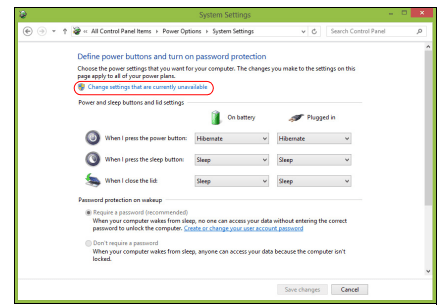
- Scroll down and disable Turn on fast startup.
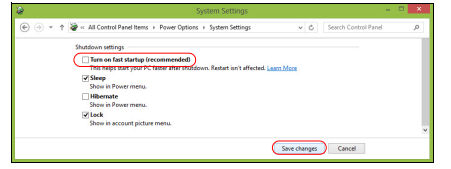
- Select Save changes.
TRAVELING WITH YOUR COMPUTER
This section gives you tips and hints to consider when moving around or traveling with your computer.
Disconnecting from the desktop
Follow these steps to disconnect your computer from external accessories:
- Save any open files.
- Remove discs from optical drive.
- Shut down the computer or put it into Sleep or Hibernate mode.
- Close the display cover.
- Disconnect the cord from the AC adapter.
- Disconnect the keyboard, pointing device, printer, external monitor and other external devices.
- Disconnect the Kensington lock if you are using one to secure the computer
Moving around
When you are just moving within short distances, for example, from your office desk to a meeting room.
Preparing the computer
Before moving the computer, close and latch the display cover to place it in Sleep mode. You can now safely take the computer anywhere you go within the building. To wake the computer from Sleep mode, open the display and, if necessary, press and release the power button.
If you are taking the computer to a client's office or a different building, you may choose to shut down the computer:
Press the Windows key + C, click Settings > Power then click Shut Down
Or:
You can put the computer in Sleep mode by pressing the Sleep hotkey or by closing the display.
When you are ready to use the computer again, open the display and, if necessary, press and release the power button.
What to bring to meetings
If your meeting is relatively short, you probably do not need to bring anything with you other than your computer. If your meeting will be longer, or if your battery is not fully charged, you may want to bring the AC adapter with you to plug in your computer in the meeting room. If the meeting room does not have an electrical outlet, reduce the drain on the battery by putting the computer in Sleep mode. Press the Sleep hotkey or close the display cover whenever you are not actively using the computer.
Taking the computer home
When you are moving from your office to your home or vice versa.
Preparing the computer
After disconnecting the computer from your desktop, follow these steps to prepare the computer for the trip home:
- Check that you have removed all media and compact discs from the drive(s). Failure to remove the media can damage the drive head.
- Pack the computer in a protective case that can prevent the computer from sliding around and cushion it if it should fall.
What to take with you
Unless you have some items at home, take the following items with you:
- AC adapter and power cord.
- The printed Setup Guide.
Special considerations
Follow these guidelines to protect your computer while traveling to and from work:
- Minimize the effects of temperature changes by keeping the computer with you.
- If you need to stop for an extended period of time and cannot carry the computer with you, leave the computer in the trunk of the car to avoid exposing the computer to excessive heat.
- Changes in temperature and humidity can cause condensation. Allow the computer to return to room temperature, and inspect the screen for condensation before turning on the computer. If the temperature change is greater than 10° C (18° F), allow the computer to come to room temperature slowly. If possible, leave the computer for 30 minutes in an environment with a temperature between outside and room temperature.
Setting up a home office
- If you frequently work on your computer at home, you may want to purchase a second AC adapter for use at home. With a second AC adapter, you can avoid carrying the extra weight to and from home.
- If you use your computer at home for significant periods of time, you might also want to add an external keyboard, monitor or mouse.
Traveling with the computer
When you are moving within a larger distance, for instance, from your office building to a client's office building or traveling locally
Preparing the computer
- Prepare the computer as if you were taking it home. Make sure that the battery in the computer is charged. Airport security may require you to turn on your computer when carrying it into the gate area.
What to take with you
Take the following items with you:
- AC adapter
- Additional printer driver files if you plan to use another printer
Special considerations
In addition to the guidelines for taking the computer home, follow these guidelines to protect your computer while traveling:
- Always take the computer as carry-on luggage.
- If possible, have the computer inspected by hand. Airport security Xray machines are safe, but do not put the computer through a metal detector.
Traveling internationally
When you are moving from country to country.
Preparing the computer
- Prepare the computer as you would normally prepare it for traveling.
What to bring with you
Bring the following items with you:
- AC adapter.
- Power cords that are appropriate for your destination(s).
- Additional printer driver files if you plan to use another printer.
- Proof of purchase, in case you need to show it to customs officials.
- International Travelers Warranty passport.
Special considerations
Follow the same special considerations as when traveling with the computer.
In addition, these tips are useful when traveling internationally:
- When traveling in another country, check that the local AC voltage and the AC adapter power cord specifications are compatible. If not, purchase a power cord that is compatible with the local AC voltage. Do not use converter kits sold for appliances to power the computer.
- If you are using the modem, check if the modem and connector are compatible with the telecommunications system of the country you are traveling in.
UNIVERSAL SERIAL BUS (USB)
- The USB port is a high-speed port which allows you to connect USB peripherals, such as a mouse, an external keyboard, additional storage (external hard disks), or any other compatible device.
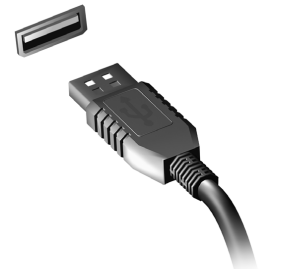
- You can also charge devices such as tablets, smartphones, or other devices through a USB port. Some USB 3.0 ports support charging devices when the computer is in Hibernate or turned off. Additionally, you can use a USB hub to connect multiple devices to a single USB port
USB TYPE-C PORT
- A USB Type-C port is a connector that allows you to easily connect USB Type-C peripherals, such as additional storage (e.g. an external drive), or any other compatible device. The Type-C port is reversable; connectors may be inserted with either side up
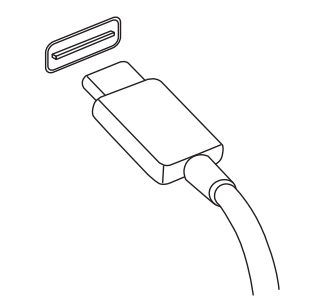
SD CARD READER
SD (Secure Digital) cards are used in a wide selection of digital cameras, tablets, media players and cellular phones.

Inserting an SD card
- Align the card so that the connector points towards the port, with the connectors facing down.
- Carefully slide the card into the port. If you find you need to use any force to insert the card, try reorientating the card slightly.
- Push the card until it clicks into place. A few millimetres of the card will extend from beyond the slot.
If the card contains some files, the Windows AutoPlay window may appear (this depends on the contents of the card) and ask you if you wish to use a program to access the contents of the card.
SD, SDHC and SDXC cards
- Different types of SD cards cover different capacities, while using the same overall design. SD cards contain up to 4 GB; SDHC cards contain up to 32 GB; and SDXC cards can contain up to 2048 GB (2 TB). Your computer provides an SDHC or SDXC compatible card reader.
VIDEO AND AUDIO CONNECTORS
Add an external monitor to your computer via a video port. The type of port available depends on your computer’s configuration.
Connecting a monitor
- Check that the computer is powered off and the monitor power switch is turned off.
- Attach the video cable to the monitor port on the computer.
- Connect the monitor power cable and plug it into a properly grounded wall outlet.
- Follow any setup instructions in the monitor's user's guide.
- Turn on power to the monitor, then the computer.
- The correct resolution and refresh rate should be detected automatically. If necessary, change the display settings used by the computer.
Headphones and microphone
- One or more 3.5 mm jacks on your computer allow you to connect audio devices.
- Use the headphone port to plug in stereo headphones or powered speakers; connecting an audio device to the headphone port disables the built-in speakers.
- Use the microphone port to connect an external microphone; connecting a microphone disables the built-in microphone.
HDMI
- HDMI (High-Definition Multimedia Interface) is a high-quality, digital audio/video interface. HDMI allows you to connect any compatible digital audio/video source, such as your computer, a set-top box, DVD player, and audio/video receiver to any compatible digital audio and/or video monitor, such as a digital television (DTV) with a single cable.
- The single cable keeps everything neat and tidy while ensuring easy connection and the best audio and visual quality
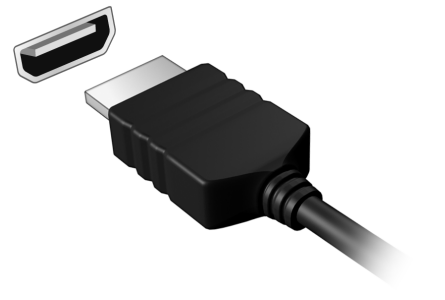
FREQUENTLY ASKED QUESTIONS
The following is a list of possible situations that may arise during the use of your computer. Easy solutions are provided for each one.
1. I turned on the power, but the computer does not start or boot up.
Check if power is being supplied to the computer (if your computer has a power indicator, it will be off); if there is no power, check the following:
- If you are using on the battery, it may be low and unable to power the computer. Connect the AC adapter to recharge the battery pack. You may need to wait a few minutes before trying to turn your computer on again.
- Make sure that the AC adapter is properly plugged into the computer and to the power outlet.
If power is being supplied to the computer, check the following:
- Do you have a USB storage device (USB drive, CD drive or smartphone) plugged into your computer? Unplug it and press Ctrl + Alt + Del to restart the system.
2. Nothing appears on the screen.
The computer’s power management system automatically blanks the screen to save power. Press any key to turn the display back on.
If pressing a key does not turn the display back on, three things might be the cause:
- The brightness level might be too low. Use the Brightness up hotkey to adjust the brightness level.
- The display device might be set to an external monitor. Press the display toggle hotkey to toggle the display back to the computer.
- The computer may be in Sleep or Hibernate mode (if there is a power LED, it will flash). Press and release the power button to resume.
3. No audio is heard from the computer.
Check the following:
- The volume may be muted. Look at the volume control (speaker) icon in the taskbar. If it is crossed-out, click the icon and deselect the Mute all option.
- The volume level may be too low. Check the volume from the volume control (speaker) icon in the taskbar. You can also use the volume control hotkeys to adjust the volume.
- If headphones, earphones or external speakers are connected to the headphone jack on the computer, the internal speakers automatically turn off.
4. The keyboard does not respond.
Try attaching an external keyboard to a USB port on the computer. If it works, contact your dealer or an authorized service center as the internal keyboard cable may be loose.
5. The printer does not work.
- Make sure that the printer is connected to a power outlet and that it is turned on.
- Make sure that the printer cable is connected securely to a USB port and the corresponding port on the printer.
6. I want to restore my computer to its original settings.
Note: If your system is the multilingual version, the operating system and language you choose when you first turn on the system will be the only option for future recovery operations.
This recovery process helps you restore the C: drive with the original software content that is installed when you purchased your computer.
Warning - Your C: drive will be reformatted and all data will be erased. It is important to back up all data files before using this option.
Before performing a restore operation, please check the BIOS settings.
- Check to see if Acer disk-to-disk recovery is enabled or not.
- If there is a D2D Recovery setting in Main, make sure it is Enabled.
- Exit the BIOS utility and save changes. The system will reboot.
Note: To access the BIOS utility, press F2 when you see the Acer logo during boot up.
For more information, see Restoring your computer on page 21.
Tips and hints for using Windows 10
We know this is a new operating system that will take some getting used to, so we've created a few pointers to help you get started.
1. How do I get to Start?
Press the Windows key or select the Windows Start button on the lower left-hand corner of the screen.
- Where’s the Start button?
- The Start button will appear in the desktop taskbar. Selecting it will open Start where you can launch apps.
- How do I see all of my apps?
- Press the Windows key or select the Windows Start button and select All apps to show a list of installed apps on the computer.
2. How do I turn off my computer?
Press the Windows key or select the Windows Start button and select the power icon > Shut down. You can also turn off the computer by right-clicking the Windows Start button > Shut down or sign out > Shut down.
- Can I turn off notifications?
- You can turn off notifications so that you can leave your computer running, but not be disturbed by notifications.
- Press the Windows key or select the Windows Start button and select Settings > System > Notifications & actions. From here you can enable/disable notifications for all of your apps or choose which apps to enable/disable.
3. How do I unlock my computer?
Press the space bar and select a user account icon to unlock the computer. If your account has a password set, you will need to enter the password to continue.
Can I personalize the Lock screen?
You can personalize the lock screen with a different image, to run a slideshow of images, or to show you quick status and notifications to suit your personal needs.
To change the background, press the Windows key or select the Windows Start button and select Settings > Personalization. From here you can:
- Select a background image for the lock screen
- Turn the Slide show on or off
- Select lock screen apps.
How do I set up the lock screen slideshow?
- Press the Windows key or select the Windows Start button and select Settings > Personalization.
- Under Background, select Slideshow.
- Select Add a folder and open the folder you wish to use (your Pictures folder will open by default). Select Choose this folder to add the folder to the lock screen slideshow.
- Select a folder and select Remove to remove the folder from the lock screen slideshow.
- Change the other settings to suit your needs.
How do I move tiles?
- Select a tile and drag it to the place on Start that you want it to appear. Other tiles will be moved to accommodate the tile in its new location.
Can I arrange tiles in groups?
- Yes, you can. Select an existing tile and drag the tile to arrange Start to your liking. Right-click on an app and select Pin to Start to create a new group on Start. From here, you can drag the tile to an existing group on Start. You can give the group(s) a name and arrange the tiles within the groups to suit your needs.
Can I make tiles bigger or smaller?
- Yes, you can. Right-click on a tile and select Resize. Select a size from the menu that appears.
Can I change the screen resolution?
- Yes, you can. Move your cursor to the lower left-hand corner of the screen and type 'Control Panel' in the text box to display the results; select Control Panel > Adjust screen resolution. Alternatively, you can also right-click anywhere on the desktop and select Screen resolution.
4. How do I set the alarm?
Your computer can act as an alarm clock. Type ’Alarms’ to search for the Alarms & Clock app.
- Select an alarm from the list, or select the + in the lower-right corner to create a new alarm.
- Enter the Alarm name.
- Set the time by choosing the hour and minute.
- Select AM or PM.
- Choose which days the alarm should go off.
- Select the sound notification.
- Select the snooze time.
- Select the Save icon in the bottom right-hand corner to save the alarm.
- Select On or Off to activate or deactivate the alarm.
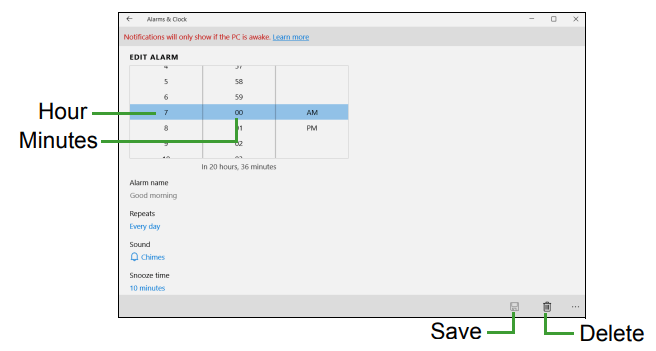
Note: The alarm will only sound if your computer is awake at the set time.
5. Where are my apps?
Move your cursor to the lower left-hand corner of the screen and select Search, start typing the name of the app you would like to open.
How do I make an app appear on Start?
- If you're in All apps and you want to make an app appear on Start, right-click an app and select Pin to Start.
How do I remove a tile from Start?
- Right-click a tile to select it and select Unpin from Start to remove the tile from Start.
How do I make an app appear on my taskbar?
- If you're in All apps and you want to make an app appear on the taskbar, right-click an app or tile and select Pin to taskbar.
How do I install apps?
- You can download Windows Store apps from Store. You will need to have a Microsoft ID to purchase and download apps from Store.
I can't find apps like Notepad and Paint! Where are they?
- Move your cursor to the lower left-hand corner of the screen and select Search. Type the name of the app you would like to open. Alternatively, open All apps and scroll to ’Windows Accessories’ to see the list of legacy programs.
6. What is a Microsoft ID (account)?
A Microsoft account is an email address and password that you use to sign in to Windows. You can use any email address, but it is best if you choose the one you already use to communicate with friends and sign in to your favorite websites. When you sign in to your PC with a Microsoft account, you'll connect your PC to the people, files, and devices you care about
Do I need one?
- You do not need a Microsoft ID to use Windows 10, but it makes life easier because you can sync data across different machines you sign in to using a Microsoft ID.
How do I get one?
- If you've already installed Windows 10 and didn't sign in with a Microsoft account or you don't have a Microsoft account and want to get one, press the Windows key or select the Windows Start button > Settings > Accounts > Sign in with a Microsoft account, and follow the onscreen instructions.
7. How do I check for Windows updates?
- Press the Windows key or select the Windows Start button > Settings > Update & recovery > Windows Update. Select Advanced options to configure the settings.
8. Where can I get more information?
For more information please visit the following pages:
- Windows 10 information: go.acer.com/windows-tutorial
- Support FAQs: support.acer.com
Troubleshooting
This chapter shows you how to deal with common system problems. Read it before calling a technician if a problem occurs. Solutions to more serious problems require opening up the computer. Do not attempt to open the computer yourself; contact your dealer or authorized service center for assistance.
Troubleshooting tips
This computer incorporates an advanced design that delivers onscreen error message reports to help you solve problems. If the system reports an error message or an error symptom occurs, see "Error messages" below. If the problem cannot be resolved, contact your dealer.
Error messages
If you receive an error message, note the message and take the corrective action. The following table lists the error messages in alphabetical order together with the recommended course of action
| Error messages | Corrective action |
| CMOS battery bad | Contact your dealer or an authorized service center |
| CMOS checksum error | Contact your dealer or an authorized service center. |
| Disk boot failure | Insert a system (bootable) disk, then press Enter to reboot. |
| Equipment configuration error | Press F2 (during POST) to enter the BIOS utility, then press Exit in the BIOS utility to reboot. |
| Hard disk 0 error | Contact your dealer or an authorized service center. |
| Hard disk 0 extended type error | Contact your dealer or an authorized service center. |
| I/O parity error | Contact your dealer or an authorized service center. |
| Keyboard error or no keyboard connected | Contact your dealer or an authorized service center. |
| Keyboard interface error | Contact your dealer or an authorized service center. |
| Memory size mismatch | Press F2 (during POST) to enter the BIOS utility, then press Exit in the BIOS utility to reboot. |
If you still encounter problems after going through the corrective measures, please contact your dealer or an authorized service center for assistance.
See other models: T272HL bmjjz Z35 bmiphz SB230 Bbix AN515-51-55WL TC-780-AMZKi5

